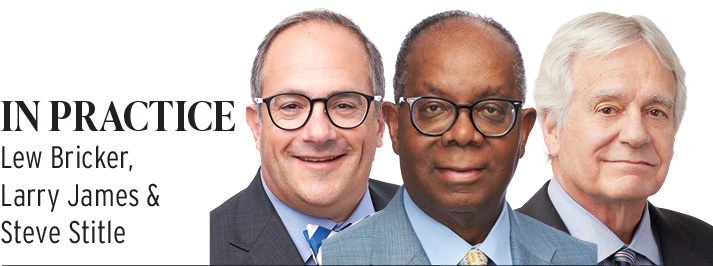Subscriber Benefit
As a subscriber you can listen to articles at work, in the car, or while you work out. Subscribe Now It seems these days that the only opportunity for mid-sized firms to expand geographic reach or to grow bench strength and revenue is to acquire or combine with like-minded competitors. For smaller firms, business pressures like technology advancement, data security, retention of talent, regulatory compliance and market globalization are nearly impossible to manage. The most efficient and cost-effective way to handle these issues is to combine with an already existing firm infrastructure. All these factors played a part in the marriage of Amundsen Davis, a Chicago-headquartered firm of 240 attorneys with offices across the Midwest (including Indianapolis) and Crabbe Brown & James, a storied 80-year-old Columbus, Ohio, firm of 10 attorneys.
It seems these days that the only opportunity for mid-sized firms to expand geographic reach or to grow bench strength and revenue is to acquire or combine with like-minded competitors. For smaller firms, business pressures like technology advancement, data security, retention of talent, regulatory compliance and market globalization are nearly impossible to manage. The most efficient and cost-effective way to handle these issues is to combine with an already existing firm infrastructure. All these factors played a part in the marriage of Amundsen Davis, a Chicago-headquartered firm of 240 attorneys with offices across the Midwest (including Indianapolis) and Crabbe Brown & James, a storied 80-year-old Columbus, Ohio, firm of 10 attorneys.
Strategically, Amundsen Davis has no plan to grow for the sake of reaching some specific size or firm ranking. At the same time, the firm’s newest partner, Larry James, expresses its sentiment precisely when, of the combination, he told his clients, “If you don’t grow, you’re going to perish; if you cannot be clear about your future, you are dead.” Mr. James happens to the “James” in Crabbe Brown & James.
Choosing when, where and how to expand the firm is one of the biggest strategic issues firm leadership tackles each year. Since 2020, Amundsen Davis has been targeting Columbus for expansion for obvious economic reasons: the fast pace of its growth, the sectors it supports, and the young, hungry talent pool are all attractive. Its proximity to existing firm operations in Indianapolis was also very appealing.
Finding a partner that fit the firm, though, was not as easy. After meticulous due diligence, assessments of cultural compatibility and assurance that business goals aligned (a process that took several years), Crabbe Brown and James rose as the unequivocal best choice for Amundsen Davis for three reasons. First, its practice was already very complementary to Amundsen Davis. Second, the Crabbe Brown & James attorneys added a bench strength to several of the firm’s service teams that had been very difficult to find in today’s market. And third, though probably most important, it was obvious that Crabbe Brown & James offered an opportunity to blend already compatible operational cultures.
Integrating an entire firm into an existing operation the size of Amundsen Davis is no easy feat. Successful integration requires careful planning, clear communication, and a willingness to adapt and align the different aspects of both firms to create a cohesive, efficient and competitive new entity.
Planning for the onboarding of the new office started in earnest while the ink was still wet on the combination contract. For Amundsen Davis, integration goes far beyond opening files and billing under a new name. It’s all the cultural norms and little habits of the firm, the idiosyncrasies the firm carries, the policies and procedures it operates under day-to-day — from when to call a snow day to celebrating employee birthdays to ordering new pens to when to require client retainers, to name just a few examples. Take on top of that training a well-established workforce on an entirely new suite of software while still anticipating that they will keep up the pace of their normal day jobs. Combination, for either side, is not a process for the faint of heart.
As the newly expanded entity moves forward in these early weeks and months, firm leadership has the roadmap to success well-defined. As the acquiring firm, Amundsen Davis will communicate effectively with staff and clients about changes, integrate different technology systems and manage data effectively, reconcile different compensation and management structures, align different firm cultures and working styles, and maintain client relationships and timely service quality during the transition.
While this expansion into Ohio will benefit the firm as a whole, Amundsen Davis is particularly excited for the benefit it provides to the firm’s Indiana operations. Indianapolis and Columbus offer complementary economic opportunities. Indianapolis has strengths in sectors like pharmaceuticals, motorsports and finance, whereas Columbus is known for its government presence, education sector (being home to Ohio State University) and a growing tech industry. The firm’s Indianapolis office has already been the beneficiary of some of this. Each new client brought into the firm’s Indianapolis office equates to more tax dollars for the state, a greater pool of connections that current clients can rely upon when doing their own business with the firm, as well as the increased need to hire attorneys and staff from the Indianapolis community. A win all around.
In a competitive legal market, a successful combination can be a powerful statement, enhancing both reputation and brand value. This enhancement in turn leads to increases in talent acquisition and development as well as client work. Amundsen Davis plans to ensure this opportunity is utilized to its fullest.•
__________
Lew Bricker is firm managing partner, Larry James is Ohio managing partner and Steve Stitle is Indiana managing partner at Amundsen Davis. Opinions expressed are those of the authors.
Please enable JavaScript to view this content.
